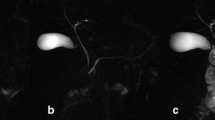Abstract
Background
The indications for MR cholangiopancreatography (MRCP) in children, and its safety and findings, might differ from those in adults and are not well described.
Objective
To investigate the safety, feasibility, and accuracy of MRCP in children.
Materials and methods
We reviewed all prospective MRCP reports, noting the indication, the use of secretin, endoscopic retrograde cholangiopancreatography (ERCP) findings, and patient outcomes. Two readers reviewed each MRCP study by consensus to rate duct visualization and compare pancreatic duct sizes before and after secretin administration (paired t-test). The likelihood of a normal versus an abnormal MRCP study was compared by gender, pancreatitis as the primary indication, secretin use, and whether ERCP was performed (Fisher’s exact test), as well as age (t-test).
Results
A total of 85 MRCP studies were performed in children (mean age 10.3 years), most commonly for evaluation of pancreatitis (n=47, 55%); 41 (48%) used secretin and 39 (46%) used a negative oral contrast agent. Of the 85 studies, 72 (85%) had excellent image quality and 43 were normal. ERCP was performed after 16 of the 85 MRCP studies (19%); the diagnoses were concordant with those of MRCP in 13 (81%). There were 42 abnormal MRCP studies, and these were more likely to be in girls (P=0.03) and in children who had undergone ERCP (P<0.01). Secretin and the negative oral contrast agent were well-tolerated. Secretin improved duct visualization (P<0.001).
Conclusion
MRCP safely and accurately depicted pancreaticobiliary anatomy in children. The use of secretin improved visualization of the pancreatic duct.











Similar content being viewed by others
References
Robertson MA (1996) Pancreatitis. In: Walker WA (ed) Pediatric gastrointestinal disease, 2nd edn. Mosby, St. Louis, pp 1451–1452
Benifla M, Weizman Z (2003) Acute pancreatitis in childhood: analysis of literature data. J Clin Gastroenterol 37:169–172
Francois E, Deviere J (2002) Endoscopic retrograde cholangiopancreatography. Endoscopy 34:882–887
Barish M, Soto J, Ferrucci J (1997) Magnetic resonance pancreatography. Endoscopy 29:487–495
Punwani S, Gillams AR, Lees WR (2003) Non-invasive quantification of pancreatic exocrine function using secretin-stimulated MRCP. Eur Radiol 13:273–276
Akisik M, Sandrasegaran K, Aisen A et al (2006) Dynamic secretin-enhanced MR cholangiopancreatography. Radiographics 26:665–667
Guibaud L, Lachaud A, Touraine R et al (1998) MR cholangiography in neonates and infants: feasibility and preliminary applications. AJR 170:27–31
Arcement CM, Meza MP, Arumanla S et al (2001) MRCP in evaluation of pancreaticobiliary disease in children. Pediatr Radiol 31:92–97
Lin JTH, Chen YH, Ni YH et al (2001) Magnetic resonance cholangiopancreatography diagnosed pancreatitis associated choledochal cyst: report of one case. Acta Paediatr Taiwan 42:363–366
Shimizu T, Suzuki R, Yamashiro Y et al (2001) Magnetic resonance cholangiopancreatography in assessing the cause of acute pancreatitis in children. Pancreas 22:196–199
Miyazaki T, Yamashita Y, Tang Y et al (1998) Single-shot MR cholangiopancreatography of neonates, infants, and young children. AJR 170:33–37
Egelhoff JC, Ball WS, Koch BL et al (1997) Safety and efficacy of sedation in children using a structured sedation program. AJR 168:1259–1262
Ueno E, Takada Y, Yoshida I et al (1998) Pancreatic diseases: evaluation with MR cholangiopancreatography. Pancreas 16:418–426
National Institutes of Health (2002) NIH state-of-the-science statement on endoscopic retrograde cholangiopancreatography (ERCP) for diagnosis and therapy. NIH Consens State Sci Statements 19:1–26
AMAG Pharmaceuticals (2007) GastroMARK package insert. http://www.amagpharma.com/documents/products/pdfs/gastromark_insert.pdf. Cited 27 Sept 2007
Manfredi R, Costamagna G, Brizi M et al (2000) Severe chronic pancreatitis versus suspected pancreatic disease: dynamic MR cholangiopancreatography after secretin stimulation. Radiology 214:849–855
Guyton AC (1991) Textbook of medical physiology, 8th edn. Saunders, Philadelphia
eMedicine (2007) Pancreas divisum. http://www.emedicine.com/radio/topic520.htm. Cited 27 Sept 2007
Gillams AR, Kurzawinski T, Lees WR (2006) Diagnosis of duct disruption and assessment of pancreatic leak with dynamic secretin-stimulated MR cholangiopancreatography. AJR 186:499–506
Shanmugam V, Beattie GC, Yule SR et al (2005) Is magnetic resonance cholangiopancreatography the new gold standard in biliary imaging? Br J Radiol 78:888–893
Matos C, Cappeliez O, Winant C et al (2002) MR imaging of the pancreas: a pictorial tour. Radiographics 22:e2
Soto JA, Lucy BC, Stuhlfaut JW (2005) Pancreas divisum: depiction with multi-detector row CT. Radiology 235:503–508
Author information
Authors and Affiliations
Corresponding author
Rights and permissions
About this article
Cite this article
Delaney, L., Applegate, K.E., Karmazyn, B. et al. MR cholangiopancreatography in children: feasibility, safety, and initial experience. Pediatr Radiol 38, 64–75 (2008). https://doi.org/10.1007/s00247-007-0644-5
Received:
Revised:
Accepted:
Published:
Issue Date:
DOI: https://doi.org/10.1007/s00247-007-0644-5




